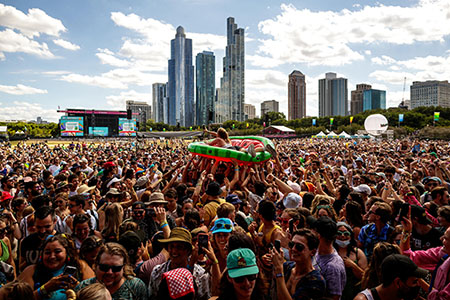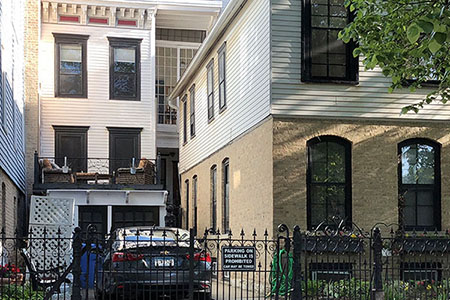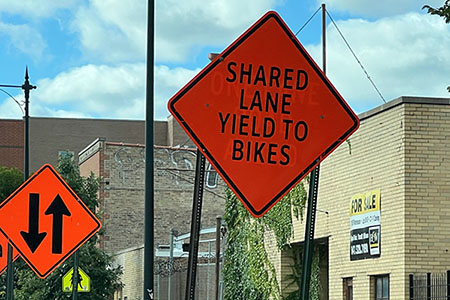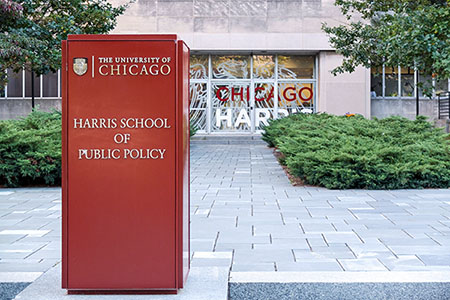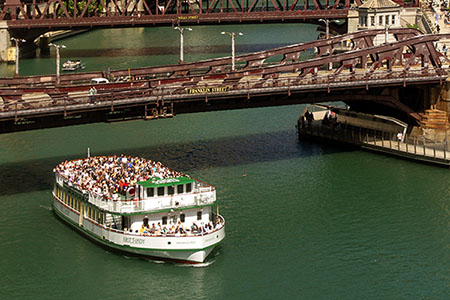
Chicago Housing Authority’s ambitious plan to redevelop Cabrini-Green into 4,080 affordable units on the same infamous land could cause history to repeat itself.
(Above) 534 West Division Street in the Cabrini-Green housing project, photographed in 1998 by Camilo J. Vergara (Library of Congress). Feb. 14, 2025 – The Chicago Housing Authority is planning the “rebirth” of the once notorious Cabrini-Green on the same land where it failed decades ago. CHA wants to build 4,080 new affordable units on vacant Cabrini-Green land south of North Avenue, and they are not all proposed as low-rise buildings and row houses. Infamous high-rises and mid-rises are part of the plan. Most are affordable housing units and likely will include hundreds of Section-8 units. The original Cabrini-Green public housing project – built on this very same historic site – was once the most notorious and crime-ridden low-income housing development in Chicago. Some say it was the worst place to live in the world. Launched in the late 1940s as a “social experiment,” Cabrini-Green quickly became synonymous with poverty, violence, and neglect. At its peak – or perhaps its low point – the development consisted of 23 high-rise buildings that housed thousands of low-income residents. The new “finalized master plan,” which the CHA says will be implemented starting in 2025, essentially repeats the great 1950s landmark public housing boondoggle drafted by planners at the request of the late Mayor Richard J. Daley, who falsely believed that stacking poor people in high-rises would solve the city’s slum-housing problems.  (Above) Overview of CHA’s new master plan. Today, clustering and stacking thousands of new CHA units on extremely valuable land that developers now consider the West Gold Coast, South Old Town, and River North neighborhoods will likely increase crime and set safe, market-rate and mixed-income residential development back another century. This writer believes this insane plan will turn the clock back to the 1940s and 1950s, creating future gang havens, with crime and drug-infested slums for our children to bear in the 2040s and 2050s. Do we want to repeat the same mistakes that created Cabrini-Green, Robert Taylor Homes, and Ida B. Wells projects? Now that they are demolished, are they only a half-forgotten memory? Notably, Mayor Richard M. Daley, son of Richard J. Daley, was the visionary mayor who razed all those projects. As real estate editor of the Chicago Sun-Times and Chicago Daily News, I have written about housing and development issues for more than five decades. It is my personal opinion, based on the negative history of more than a half century, that concentrating thousands of affordable and Section-8 housing units in one neighborhood always has a negative impact on the future of the area, especially for the development of market-rate and mixed-income housing.
The only sane way to develop affordable housing in Chicago is to mix and sprinkle low-rise units in every city neighborhood. The billion-dollar Cabrini-Green II real estate needs to be marketed for its highest and best use. Sell it at top prices to luxury housing developers, and builders of market-rate apartments and affordable units. Only 20-25 percent of this land should be developed for Section-8 housing. If the land were sold at appraised prices today, imagine how many thousands more affordable and Section-8 units could be developed, scattered in other city neighborhoods. If the CHA wants to forever hold title to this land, worth its weight in gold, then the organization could lease it to developers for 99 years, which has been successful in similar lower density developments in the area. This writer grew up at 1649 North Halsted Street in the 1950s, attended Newberry Elementary School and Lane Tech College Prep High School, and personally witnessed the destruction of West Old Town via “urban renewal” because of the negative impact of Cabrini-Green.
According to the CHA, “the master plan will guide the redevelopment of vacant lots and existing buildings over the coming years, in collaboration with private developers who will lead design teams and other aspects of the project.” The CHA said it “remains bound by all legal requirements and court orders related to Cabrini-Green, as well as the promises made when residents were relocated.” Nearly a decade after the demolition of the Cabrini-Green complex began, CHA said it is finally moving forward with its replacement. The plan is divided into four main target sites, with area residents requesting that CHA prioritize road connectivity, the preservation of some vacant rowhomes, more contiguous park space, and the relocation of Chicago Lights Urban Farm. Impact of Cabrini II The four sites will collectively bring around 4,080 new housing units to the area, which could add 20,000 or more new residents to the neighborhood. That many units surpasses the density of the most densely proposed scheme presented for Cabrini-Green II earlier this year. With some ten high-rises and many mid-rise buildings growing in size, the new plan also adds around eight new acres of green space. The updated master plan will now incorporate additional community feedback before being finalized in the first quarter of 2025. Once the final plan is approved, the CHA will begin applying for zoning changes across the sites and will release site-specific solicitations for development partners, starting with the first lots in 2025. Here are details on each of the four phases: Phase 1. The area near the intersection of West Chicago Avenue & North Larrabee Street will start with the extension of Locust Street, along with the expansion, removal, and addition of other surrounding roads. Durso Park will also be extended as a linear park all the way to Seward Park, featuring a memorial walk and connecting to a relocated Chicago Lights Urban Farm.  (Above) Google map of area. This portion will include ten renovated rowhomes with green space surrounding them. The plan also includes the construction of a new high-rise, four mid-rise buildings, 61 new townhomes, and several low-rise buildings, providing more than 1,000 new units. Some buildings will feature ground-floor retail space, and most will include parking. Phase 2. Located across from the expanded Durso Park and centered around North Sedgwick Street, this site will see the extension of Sedgwick and the restoration of the grid with Walton Street. This area will include several six-flat buildings, 18 new townhomes, a high-rise, and multiple mid-rise and low-rise buildings. This will also be the home of the relocated Chicago Lights Urban Farm that currently is along Chicago Avenue. Phase 3. Located on Division Street to the west of Target and bounded by North Halsted Street, this area will include two new roads and is expected to be one of the densest portions of the redevelopment. The plan includes small parks, nine new townhomes, a high-rise, and several mid-rise buildings, potentially featuring ground-floor retail and on-site parking. This site will connect to Stanton Park to the north. Phase 4. This portion, the most complex of all four sites, spans multiple smaller lots around the intersection with North Clybourn Avenue. However, no additional roads will be needed here. The current City Farm Chicago will be relocated behind Target to make room for low-rise and mid-rise buildings, as well as eight-flat and six-flat buildings. A small park will be created in front of Stranger’s Home MB Church. In addition to this plan, several other projects around Cabrini-Green are already underway, including 1450 North Larrabee Street, Parkside Phase 3, and 547 West Oak Street, which will contribute an additional 1,000 housing units to the area. On December 20, one outspoken Near North Side resident made the following comments on the CHA Cabrini-Green II website: “This land should be liquidated to the highest bidders for 100 percent market-rate housing that generates the most return to the taxpayers. This is our land, we the tax-paying people. Fight for it, vote them out. If you want to see this city live up to its potential then unshackle it from the oppressive tyranny of big government.” Another Near North Side resident agreed. “Government agencies will always be plagued by outdated covenants, bureaucratic gridlock, and the inability to attract human talent that can actually execute. If the CHA functioned as a real oversight agency over private operators, then maybe things would move a lot quicker,” said the resident. “A mix of market rate, affordable, and Section-8 housing should have already been built and benefited everyone if we had a responsible overseer in charge and the political will.” NEXT: The far-reaching impact of the construction of Cabrini-Green on one extended Old Town family and their friends over decades. |





